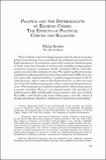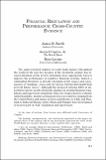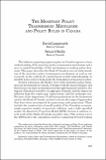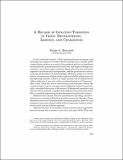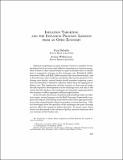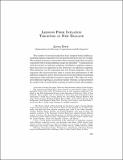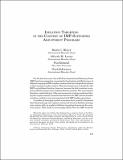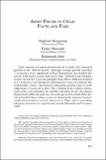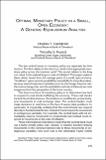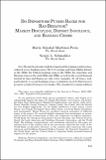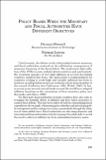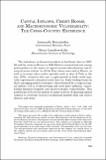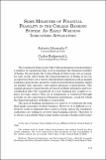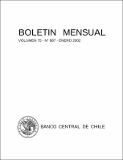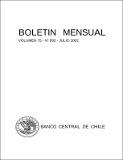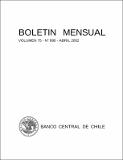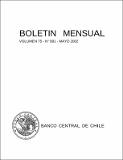Buscar
Mostrando ítems 1-20 de 228
Politics and the determinants of banking crises: the effects of political checks and balances
There is likely to be little disagreement with the observation that political interference has exacerbated the problems associated with bank insolvencies. Nevertheless, most ot the analytical attention given to bank crises has focused on technocratic mistakes (inappropriate regulatory choices), exogenous ...
Financial regulation and performance: cross-country evidence
The unprecedented number of costly bank failures throughout the world in the last two decades of the twentieth century has focused attention on the need to determine more appropriate ways to improve the performance of countries financial systems. Indeed, a substantial literature is already emerging ...
The monetary policy transmission mechanism and policy rules in Canada
The inflation targeting regime in place in Canada requires a clear understanding of the monetary policy transmission mechanism and a way to exploit knowledge of that mechanism in making policy decisions. This paper describes the Bank of Canada's current undestanding of the monetary policy transmission ...
The monetary transmission mechanism in the United Kingdom: pass-through and policy rules
A number of recent papers have used policy simulations from small empirical macroeconomic models to assess the efficacy of inflation targeting or, more precisely, inflation forecast targeting (Svensson, 1997a). These include Rudebush and Svensson (1999). The models used to undertake these simulations ...
Inflation targeting in Brazil: shocks, backward-looking prices, and IMF conditionality
In mid-January 1990, Brazil abandoned its crawling exchange rate band. Surprisingly enough, the country's economic performance in the aftermath of this episode was much better than expected, given the performance of other emerging market economies after a move toward floating. Despite the large ...
A decadeof inflation targeting in Chile: developments, lessons, and challenges
In the twentieth century, Chile experienced most monetary and exchange rate regimes. Periods of fixed exchange rates usually ended in speculative attacks as a result of inconsistent policies or significant external shocks, generating serious real costs and larger exchange rate volatility.
New frontiers for menetary policy in Chile
Inflation targeting can be broadly defined as a framework for the conduct of MONETARY POLICY in which the central bank guides its instruments in order to hold inflation near a preannounced target or to bring back to the target. Although understanding the framework is straightfoward, its practical ...
Inflation targeting and the inflation process: lessons from an open economy
Inflation targeting in an open economy insolves a number of complexities that do not arise with inflation targeting in a clises economy. One of these is that central banks in open economies have to decide how to repond to changes in the exchange rate.
Lessons from inflation targeting in New Zealand
The number of central banks that have adopted formal inflation targeting regimes expanded over the past decade from only one to eight. The number increases even further when central banks that set policy consistent with a formal inflation target are included. Commesurate with the formal or informal ...
Inflation targeting in the context of IMF-Supported adjustment programs
For the last few years, the staff of the Iternational Monetary Fund (IMF) has been engaged in assessing the functioning and effectiveness of inflation targeting in IMF member countries that have adopted this scheme as their monetary policy anchor. This involvement was restricted to the IMF's surveillance ...
Asset prices in Chile: facts and fads
Chile enjoyed an unprecedent period of rapid and sustained growth in the 1986-98 period. Although average growth exceeded 7.1 percent a year, significant cyclical fluctuations also marked the period, both across sectors and across time. Growth in the tradable sectors exceeded 6.7 percent annually from ...
Optimal monetary policy in a small, open economy: a general-equilibrium analysis
The two central issues in monetary policy are separated by time horizon. The first relates to the short run: what is the appropriate monetary policy across the business cycle? The second relates to the long run: waht is the optimal long-run rate of inflation? This paper explores these classic issues ...
Do depositors punish banks for bad behavior? market discipline, deposit insurance, and banking crises
Over the last two decades, both developed and developing countries have endured severe banking crises. The U.S. savings and loans (S&Ls) debacle in the 1980s, the chilean banking crisis in the 1980s, the Argentine and Mexsican crises in the mid-1980s and 1990s, as well as the recent financial turmoil ...
Policy biases when the monetary and fiscal authorities have different objectives
Until recently, the debate on the relationship between monetary and fiscal authorities centered on the inflationary consequences of mentary financing of the fiscal deficit. The moderately high inflation of the 1970s in some industrialized countries and, particularly, the recurring episodes of very ...
Capital inflows, credit booms, and macroeconomic vulnerability: the cross-country experience
The turbulence in financial markets is Southeast Asia in 1997-98 and the crisis in Mexico in 1994-95 have renewed interest among policymarkers in the issues of capital account liberalization and financial sector reform. In all the East Asian cases and in Mexico, as well as in many other earlier episodes ...
Some measures of financial fragility in the chilean banking system: an early warning indicators application
The regulatory framework of the chilean financial system includes a number of regulations that seek to maintain the financial stability of banks. On one hand, the Central Bank of Chile in its role as regulator and, on the other hand, the Superintendency of Banks in its role as supervisor have set a ...
Boletín mensual
Esta publicación, creada en enero de 1928, contiene estadísticas de los principales indicadores de actividad y empleo, información monetaria y financiera, precios y salarios, exportaciones e importaciones, balanza comercial, balanza de pagos, reservas internacionales, inversión extranjera, inversión ...
Boletín mensual
Esta publicación, creada en enero de 1928, contiene estadísticas de los principales indicadores de actividad y empleo, información monetaria y financiera, precios y salarios, exportaciones e importaciones, balanza comercial, balanza de pagos, reservas internacionales, inversión extranjera, inversión ...
Boletín mensual
Esta publicación, creada en enero de 1928, contiene estadísticas de los principales indicadores de actividad y empleo, información monetaria y financiera, precios y salarios, exportaciones e importaciones, balanza comercial, balanza de pagos, reservas internacionales, inversión extranjera, inversión ...
Boletín mensual
Esta publicación, creada en enero de 1928, contiene estadísticas de los principales indicadores de actividad y empleo, información monetaria y financiera, precios y salarios, exportaciones e importaciones, balanza comercial, balanza de pagos, reservas internacionales, inversión extranjera, inversión ...

